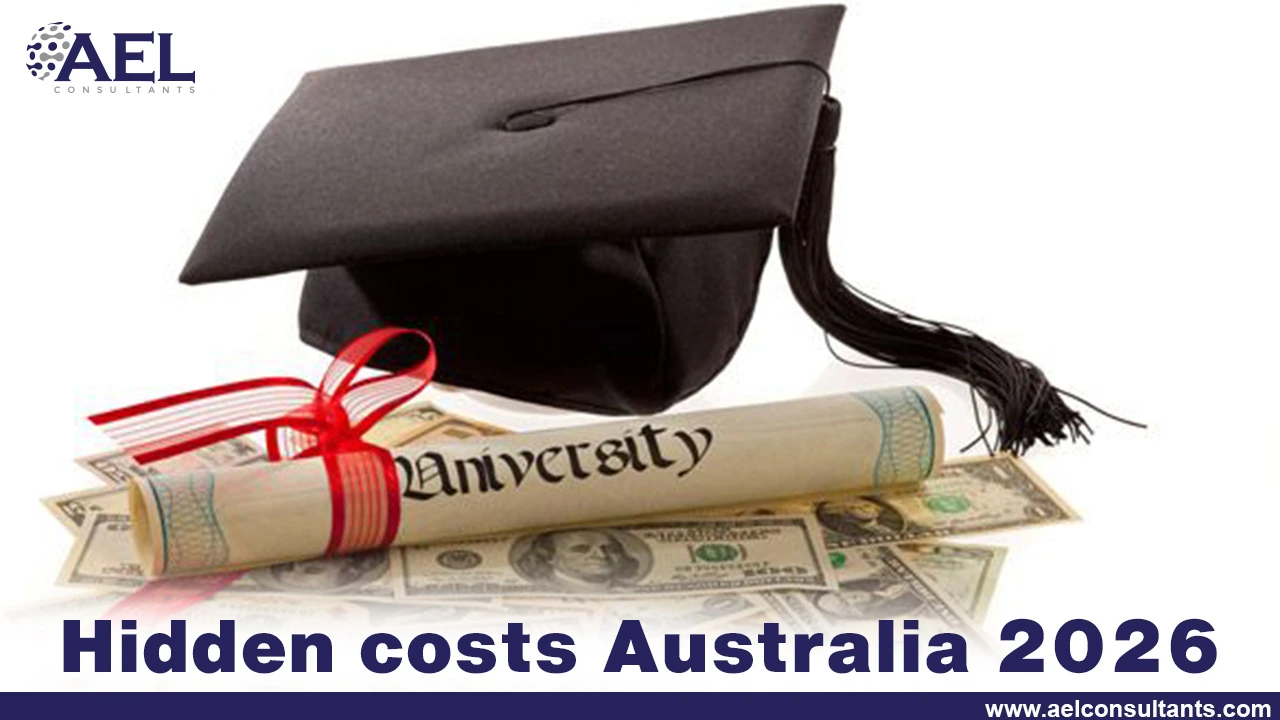Have you questioned why, despite thorough planning, so many overseas students in Australia discover their costs to be more than anticipated? Australia 2026’s hidden expenses actually silently deplete your finances if you’re not ready.
Understanding these unanticipated costs Australia students encounter can enable you to better plan and prevent shocks, whether you are relocating to Sydney, Melbourne, or Perth for school.
Australia is still among the most popular places in the world to study, but behind all the buzz is a network of daily expenses that are sometimes forgotten. — from travel and medical insurance to course materials and entertainment costs. This handbook reveals the covert expenses affecting your 2026 budget and offers concrete advice to keep them under control.
Knowing the actual cost of life in Australia
Government data shows that the average foreign student spends between AUD 25,000 and 35,000 yearly on accommodation costs. That excludes, though, some ongoing expenditures like visa renewals, public transport passes, or emergency health care bills, which mount up rapidly.
Surviving financially as a student requires knowing where your money actually goes rather than only lowering expenses. Depending on the city, the cost of living differs; usually, Sydney is 20% more costly than Hobart or Adelaide. For this reason, before relocating, you should look into the living conditions of your city.
Visa and Documentation Fees First Surprise
Although it is clear that flight and tuition fees exist, many students neglect the supplementary paperwork expenses. At present, applying for a student visa (subclass 500) costs around AUD 710, but this may increase with biometrics, police checks, and medical examinations.
Additional secret expenses are:
- Depending on your insurer, Overseas Student Health Cover (OSHC) is required for all overseas students and might range from AUD 500 to AUD 700 yearly.
- Renewal of Visa: Those remaining more than planned pay fees.
- Usually needed for formal submissions are document attestation and translations.
- Before your first class even starts, these starting administrative expenses can rapidly exceed AUD 1,000.
Accommodation and Utility Expenditures Beyond Rent
Though it is indeed your most significant housing expense, rent is not the only factor in play. Australia’s hidden costs for 2026 housing include amenities like:
Gas and Electricity: AUD 100 to 150 every month.
- AUD 70–100 each month for Internet and mobile data.
- Bond Payments: Generally, four weeks’ worth of rent is due in advance as a security deposit.
- Not all rentals are furnished; initially setting up a little studio can run from AUD 1,000 to 1,500.
- Little things like heating bills in the winter can add hundreds of dollars every semester. To cut your general costs, think about sharing housing.
Travel and transportation costs
Many students fail to appreciate the daily travel expenses they incur. A single bus ride in cities like Sydney or Brisbane costs AUD 3–5, and monthly travel passes average AUD 150–200.
More unanticipated costs connected with travel for Australian students include:
Early or late arrival, airport transfers, and cab services.
Public Transportation: Not tapping cards properly will result in penalties.
For students residing in suburban regions in particular, travel to the Campus or Work Placements.
Save money by riding your bike to school, using student concession cards, or residing close to public transportation lines. Rising fuel prices in 2026 will make transport planning absolutely essential.
Expenditures for technology and instructional resources
New students are sometimes taken aback by software licenses, stationery, and books. Each university textbook might cost AUD 100–200; even used copies may not always be accessible.
Get ready for: Digital learning is now the norm in 2026
Laptop and accessories: AUD 1,000–1,800.
Paid Software (such as SPSS, Adobe, or MATLAB): AUD 30–60 a month.
Cost per page for scanning and printing: AUD 0.20–0.40.
Tip: Lower expenses by using free e-books from your college library as well as student software access initiatives.
Medical, Insurance, and Dental Costs
Health crises might throw off even the best-laid finances. OSHC could not cover everything, and you could have to pay out-of-pocket for:
- AUD 150–300 per session for dental visits.
- Eye Examinations or Prescription Glasses: AUD 200–400.
- Specialist Consultations: Each visit costs AUD 70–150.
- It’s crucial to have an emergency medical fund ranging from AUD 500 to AUD 1,000. Many colleges also have on-campus clinics providing reduced prices; utilize them.
Groceries, Dining, and Costs for Living
Another area where underlying expenses in Australia 2026 stealthily appear is food. Dining out as little as twice a week might deplete your monthly budget by AUD 300–400.
Common expenses’ decomposition:
- Weekly groceries range from AUD 80 to 120.
- Eating Out: Every meal costs AUD 15–25.
- Cafés and Coffee Runs: AUD 4–7 for each cup.
- Cook in large quantities, shop during supermarket discount hours, and connect with social media student food-sharing organizations to save.
Tax-Related Expenses and Part-Time Employment
Although it’s a typical approach for students to help themselves, working part-time carries less well-known expenses:
- Registration of Tax File Number (TFN) (free but required).
- Travel to Works Sites.
- Meal and clothing prices for retail or hospitality employment.
- The ATO tightens reporting rules in 2026, so part-time workers must maintain meticulous income records to prevent penalties.
Entertainment, subscriptions, and social life
Living in Australia entails more than only studying. Social and recreational costs, though, usually come without planning. Movie evenings, weekend excursions, and streaming subscriptions add up.
Examples:
- Netflix/Spotify: AUD 10–20 every month.
- Gym Memberships: AUD 40–60 every month.
- Event Tickets: Each AUD 50–150.
- Although having fun in college is crucial, monitoring these expenses keeps you financially stable.
Technology, Repairs, Hidden Maintenance Costs
Few consider repair or replacement expenses, even while your phone or laptop is your lifeline as a student.
- Phone repairs cost between AUD 200 and 400.
- AUD 150–250 for laptop battery replacement.
- Gadget Insurance: Not required, but useful if you have expensive electronics.
- Having emergency money enables one to prevent disturbances since tech breakdowns typically occur at the worst possible moments.
- Unexpected Costs for Students in Australia Sometimes Miss
- Certain expenses show up year-round rather than comfortably fit inside a budget:
- Visa Extension or Flight Modifications.
- Graduation Gown Rentals (AUD 100–150).
- Holiday Break Storage Costs.
- Travel Home in Case of Emergency.
Plan a little “just-in-case” reserve, as these are emotionally and financially draining.
Note: These costs are not exact or absolute. It all depends on students’ lifestyle and preferences that how much they spend in Australia.
Australia 2026 Tips to Handle Undercover Expenses
Track everything online: Frollo or PocketGuard are examples of programs that let you keep tabs on costs.
Establish monthly limits by dividing your income and adhering to set distributions.
Participate in Student Communities: They frequently provide rides, free activities, and furniture.
Use student discounts: Most companies, from tech stores to movies, provide discounts.
Keep at least AUD 1,000–1,500 aside for unforeseen demands by building an emergency fund.
Good money management will enable you to stay free from worry and debt during your whole stay.
Story from Experience: The Learning Process
Consider Maria, a Filipino student who relocated to Sydney in 2025. She had planned for AUD 1,200 every month, but quickly came to find her actual expenses were closer to AUD 1,800. She learnt to adjust by meal preparation, used books, and shared housing to save expenses from her new phone plan, extra lab fees, and commute to her part-time work.
Her narrative shows how vital it is to have a cushion for emergencies and to prepare for the unanticipated.
Ahead Planning with AEL Advisors
Moving to Australia is a life-changing event; thus, planning is really crucial. AEL Consultants assist students in precisely projecting living costs, selecting reasonably priced locations, and effectively handling visa paperwork.
From creating a rent budget to picking the ideal OSHC plan, their professionals offer individualized financial advice that guarantees your trip to Australia is stress-free and financially sound.
Ready to move to Australia free from financial hardship?
Reach AEL Consultants today to offer specialized advice on handling your college finances and preventing unexpected fees.
Questions Regularly Asked (FAQs)
Q1. For students in Australia in 2026, what are the main disguised expenses?
Among the most often occurring hidden expenses are utilities, travel, medical care, and study materials.
Q2. Being a student in Australia, how much should I set aside each month?
A: Essentials plus little extras are typically covered by AUD 2,000–2,500 a month.
Q3. Do overseas students have to have health insurance?
A: Yes, OSHC is needed for the whole length of your visa.
Q4. Can part-time work pay all of my living costs?
A: Although useful, part-time employment typically pays roughly 60–70% of all expenses.
Conclusion
Knowing the secret expenses in Australia 2026 will enable you to prevent unpleasant surprises and simplify your study path. Every dollar counts, from utilities and healthcare to leisure and visa fees.
Planning, monitoring your expenses, and seeking professional guidance from AEL Consultants will help you focus on what truly matters: achieving academic success while enjoying your time in one of the most vibrant student cities on Earth.






